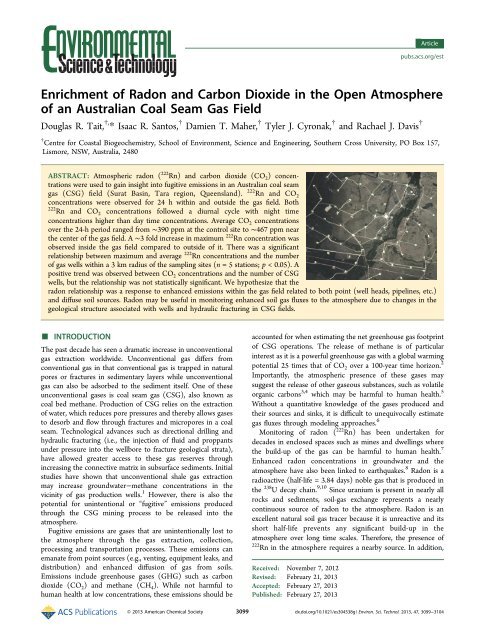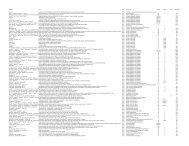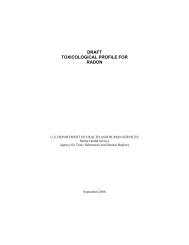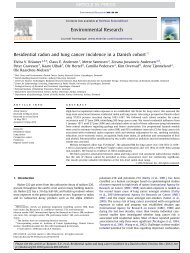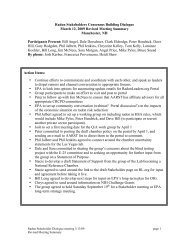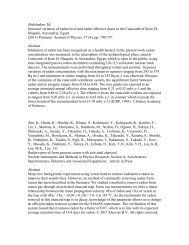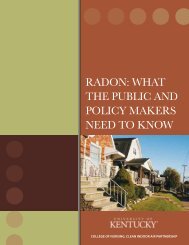Enrichment of Radon and Carbon Dioxide in the Open Atmosphere ...
Enrichment of Radon and Carbon Dioxide in the Open Atmosphere ...
Enrichment of Radon and Carbon Dioxide in the Open Atmosphere ...
You also want an ePaper? Increase the reach of your titles
YUMPU automatically turns print PDFs into web optimized ePapers that Google loves.
Articlepubs.acs.org/est<strong>Enrichment</strong> <strong>of</strong> <strong>Radon</strong> <strong>and</strong> <strong>Carbon</strong> <strong>Dioxide</strong> <strong>in</strong> <strong>the</strong> <strong>Open</strong> <strong>Atmosphere</strong><strong>of</strong> an Australian Coal Seam Gas FieldDouglas R. Tait, †, * Isaac R. Santos, † Damien T. Maher, † Tyler J. Cyronak, † <strong>and</strong> Rachael J. Davis †† Centre for Coastal Biogeochemistry, School <strong>of</strong> Environment, Science <strong>and</strong> Eng<strong>in</strong>eer<strong>in</strong>g, Sou<strong>the</strong>rn Cross University, PO Box 157,Lismore, NSW, Australia, 2480ABSTRACT: Atmospheric radon ( 222 Rn) <strong>and</strong> carbon dioxide (CO 2 ) concentrationswere used to ga<strong>in</strong> <strong>in</strong>sight <strong>in</strong>to fugitive emissions <strong>in</strong> an Australian coal seamgas (CSG) field (Surat Bas<strong>in</strong>, Tara region, Queensl<strong>and</strong>). 222 Rn <strong>and</strong> CO 2concentrations were observed for 24 h with<strong>in</strong> <strong>and</strong> outside <strong>the</strong> gas field. Both222 Rn <strong>and</strong> CO 2 concentrations followed a diurnal cycle with night timeconcentrations higher than day time concentrations. Average CO 2 concentrationsover <strong>the</strong> 24-h period ranged from ∼390 ppm at <strong>the</strong> control site to ∼467 ppm near<strong>the</strong> center <strong>of</strong> <strong>the</strong> gas field. A ∼3 fold <strong>in</strong>crease <strong>in</strong> maximum 222 Rn concentration wasobserved <strong>in</strong>side <strong>the</strong> gas field compared to outside <strong>of</strong> it. There was a significantrelationship between maximum <strong>and</strong> average 222 Rn concentrations <strong>and</strong> <strong>the</strong> number<strong>of</strong> gas wells with<strong>in</strong> a 3 km radius <strong>of</strong> <strong>the</strong> sampl<strong>in</strong>g sites (n = 5 stations; p < 0.05). Apositive trend was observed between CO 2 concentrations <strong>and</strong> <strong>the</strong> number <strong>of</strong> CSGwells, but <strong>the</strong> relationship was not statistically significant. We hypo<strong>the</strong>size that <strong>the</strong>radon relationship was a response to enhanced emissions with<strong>in</strong> <strong>the</strong> gas field related to both po<strong>in</strong>t (well heads, pipel<strong>in</strong>es, etc.)<strong>and</strong> diffuse soil sources. <strong>Radon</strong> may be useful <strong>in</strong> monitor<strong>in</strong>g enhanced soil gas fluxes to <strong>the</strong> atmosphere due to changes <strong>in</strong> <strong>the</strong>geological structure associated with wells <strong>and</strong> hydraulic fractur<strong>in</strong>g <strong>in</strong> CSG fields.■ INTRODUCTIONThe past decade has seen a dramatic <strong>in</strong>crease <strong>in</strong> unconventionalgas extraction worldwide. Unconventional gas differs fromconventional gas <strong>in</strong> that conventional gas is trapped <strong>in</strong> naturalpores or fractures <strong>in</strong> sedimentary layers while unconventionalgas can also be adsorbed to <strong>the</strong> sediment itself. One <strong>of</strong> <strong>the</strong>seunconventional gases is coal seam gas (CSG), also known ascoal bed methane. Production <strong>of</strong> CSG relies on <strong>the</strong> extraction<strong>of</strong> water, which reduces pore pressures <strong>and</strong> <strong>the</strong>reby allows gasesto desorb <strong>and</strong> flow through fractures <strong>and</strong> micropores <strong>in</strong> a coalseam. Technological advances such as directional drill<strong>in</strong>g <strong>and</strong>hydraulic fractur<strong>in</strong>g (i.e., <strong>the</strong> <strong>in</strong>jection <strong>of</strong> fluid <strong>and</strong> proppantsunder pressure <strong>in</strong>to <strong>the</strong> wellbore to fracture geological strata),have allowed greater access to <strong>the</strong>se gas reserves through<strong>in</strong>creas<strong>in</strong>g <strong>the</strong> connective matrix <strong>in</strong> subsurface sediments. Initialstudies have shown that unconventional shale gas extractionmay <strong>in</strong>crease groundwater−methane concentrations <strong>in</strong> <strong>the</strong>vic<strong>in</strong>ity <strong>of</strong> gas production wells. 1 However, <strong>the</strong>re is also <strong>the</strong>potential for un<strong>in</strong>tentional or “fugitive” emissions producedthrough <strong>the</strong> CSG m<strong>in</strong><strong>in</strong>g process to be released <strong>in</strong>to <strong>the</strong>atmosphere.Fugitive emissions are gases that are un<strong>in</strong>tentionally lost to<strong>the</strong> atmosphere through <strong>the</strong> gas extraction, collection,process<strong>in</strong>g <strong>and</strong> transportation processes. These emissions canemanate from po<strong>in</strong>t sources (e.g., vent<strong>in</strong>g, equipment leaks, <strong>and</strong>distribution) <strong>and</strong> enhanced diffusion <strong>of</strong> gas from soils.Emissions <strong>in</strong>clude greenhouse gases (GHG) such as carbondioxide (CO 2 ) <strong>and</strong> methane (CH 4 ). While not harmful tohuman health at low concentrations, <strong>the</strong>se emissions should beaccounted for when estimat<strong>in</strong>g <strong>the</strong> net greenhouse gas footpr<strong>in</strong>t<strong>of</strong> CSG operations. The release <strong>of</strong> methane is <strong>of</strong> particular<strong>in</strong>terest as it is a powerful greenhouse gas with a global warm<strong>in</strong>gpotential 25 times that <strong>of</strong> CO 2 over a 100-year time horizon. 2Importantly, <strong>the</strong> atmospheric presence <strong>of</strong> <strong>the</strong>se gases maysuggest <strong>the</strong> release <strong>of</strong> o<strong>the</strong>r gaseous substances, such as volatileorganic carbons 3,4 which may be harmful to human health. 5Without a quantitative knowledge <strong>of</strong> <strong>the</strong> gases produced <strong>and</strong><strong>the</strong>ir sources <strong>and</strong> s<strong>in</strong>ks, it is difficult to unequivocally estimategas fluxes through model<strong>in</strong>g approaches. 6Monitor<strong>in</strong>g <strong>of</strong> radon ( 222 Rn) has been undertaken fordecades <strong>in</strong> enclosed spaces such as m<strong>in</strong>es <strong>and</strong> dwell<strong>in</strong>gs where<strong>the</strong> build-up <strong>of</strong> <strong>the</strong> gas can be harmful to human health. 7Enhanced radon concentrations <strong>in</strong> groundwater <strong>and</strong> <strong>the</strong>atmosphere have also been l<strong>in</strong>ked to earthquakes. 8 <strong>Radon</strong> is aradioactive (half-life = 3.84 days) noble gas that is produced <strong>in</strong><strong>the</strong> 238 U decay cha<strong>in</strong>. 9,10 S<strong>in</strong>ce uranium is present <strong>in</strong> nearly allrocks <strong>and</strong> sediments, soil-gas exchange represents a nearlycont<strong>in</strong>uous source <strong>of</strong> radon to <strong>the</strong> atmosphere. <strong>Radon</strong> is anexcellent natural soil gas tracer because it is unreactive <strong>and</strong> itsshort half-life prevents any significant build-up <strong>in</strong> <strong>the</strong>atmosphere over long time scales. Therefore, <strong>the</strong> presence <strong>of</strong>222 Rn <strong>in</strong> <strong>the</strong> atmosphere requires a nearby source. In addition,Received: November 7, 2012Revised: February 21, 2013Accepted: February 27, 2013Published: February 27, 2013© 2013 American Chemical Society 3099 dx.doi.org/10.1021/es304538g | Environ. Sci. Technol. 2013, 47, 3099−3104
Environmental Science & TechnologyArticleFigure 1. The study site <strong>in</strong> <strong>the</strong> Surat Bas<strong>in</strong>, Tara region, Queensl<strong>and</strong>. Gas wells are <strong>in</strong>dicated by a red cross (data from http://m<strong>in</strong>es.<strong>in</strong>dustry.qld.gov.au/geoscience/<strong>in</strong>teractive-resource-tenure-maps.htm, accessed 24 October 2012). The red crosses may represent more than one well if <strong>the</strong>y are <strong>in</strong>close proximity. CO 2 (ppm) <strong>and</strong> 222 Rn (Bq m −3 ± 2σ) concentrations over a ∼24-h period are <strong>in</strong>dicated for each site. The gray areas representnight-time, while <strong>the</strong> white areas represent daytime.■radon can be easily detected by portable <strong>in</strong>struments that can EXPERIMENTAL SECTIONbe deployed <strong>in</strong> <strong>the</strong> field.We hypo<strong>the</strong>size that measurement <strong>of</strong> atmospheric 222 This study was performed <strong>in</strong> a CSG field near Tara,RnQueensl<strong>and</strong>, Australia (∼26°50′0″S, 150°20′0″E). The areaconcentrations may provide a simple <strong>and</strong> effective way to ga<strong>in</strong><strong>in</strong>sight <strong>in</strong>to fugitive emissions from CSG m<strong>in</strong><strong>in</strong>g activities. Thehas two ma<strong>in</strong> gas fields, <strong>the</strong> Tal<strong>in</strong>ga <strong>and</strong> <strong>the</strong> Kenya gas fields,aim <strong>of</strong> this study was to assess whe<strong>the</strong>r atmospheric 222 Rn <strong>and</strong>with wells <strong>in</strong> vary<strong>in</strong>g states <strong>of</strong> exploration <strong>and</strong> production. TheCO 2 concentrations are enriched with<strong>in</strong> an Australian CSG production <strong>and</strong> exploration <strong>of</strong> CSG <strong>in</strong> <strong>the</strong> area is associatedfield relative to nearby areas outside <strong>the</strong> CSG field. We with <strong>the</strong> extensive Walloon Coal Measures, which are relativelypostulate that a relationship between gas concentrations <strong>and</strong> permeable (>4.93 x10 −13 m 2 <strong>in</strong> some seams) <strong>and</strong> generally<strong>the</strong> number <strong>of</strong> nearby CSG wells will emerge if CSG extraction shallow (near surface to
Environmental Science & TechnologyWe deployed 24-h time-series stations to measure atmospheric222 Rn <strong>and</strong> CO 2 at three locations with<strong>in</strong> <strong>the</strong> gas fields<strong>and</strong> two stations outside <strong>of</strong> <strong>the</strong> gas fields (Figure 1). A gas<strong>in</strong>take was positioned at 2 m above <strong>the</strong> ground at each station.The first station (hereafter referred to as North) was adjacentto an open wheat field approximately 3 km north <strong>of</strong> <strong>the</strong> Kenyagas field <strong>and</strong> to <strong>the</strong> east <strong>of</strong> <strong>the</strong> Tal<strong>in</strong>ga gas field. The second sitewas located on a roadside reserve <strong>in</strong> <strong>the</strong> central part <strong>of</strong> <strong>the</strong>Kenya gas field (Central). The third site was located directlysouth <strong>of</strong> a large water hold<strong>in</strong>g pond <strong>in</strong> <strong>the</strong> Kenya gas field(East). The fourth site was located approximately 3 km south <strong>of</strong><strong>the</strong> Kenya gas field (South). The fifth site was locatedapproximately 8 km from <strong>the</strong> sou<strong>the</strong>rn boundary <strong>of</strong> <strong>the</strong> Kenyagas field (Control). For each site, <strong>the</strong> distance to <strong>the</strong> nearestwell <strong>and</strong> <strong>the</strong> number <strong>of</strong> nearby wells are <strong>in</strong>dicated <strong>in</strong> Table 1.Table 1. Position <strong>and</strong> Proximity <strong>of</strong> Sampl<strong>in</strong>g Sites to CSGWell Heads asitenorthcentraleastsouthcontrollat/long26° 53′S,150° 24′E26° 57′S,150° 25′E26° 57′S,150° 28′E27° 1′S,150° 27′E27° 5′S,150° 20′E∼distance tonearest gas well(m)1(km)wells with<strong>in</strong>2(km)3(km)4(km)60 4 15 27 51500 4 17 36 63250 1 9 19 271500 0 2 5 74400 0 0 0 0a The location <strong>of</strong> well heads was obta<strong>in</strong>ed from www.m<strong>in</strong>es.<strong>in</strong>dustry.qld.gov.au/geoscience/<strong>in</strong>teractive-resource-tenure-maps.htm, accessed24 October 2012.Measurements <strong>of</strong> 222 Rn concentrations were performed us<strong>in</strong>ga commercially available cont<strong>in</strong>uous radon-<strong>in</strong>-air monitor(RAD-7, Durridge Company), with two-hour averag<strong>in</strong>g<strong>in</strong>tervals to ensure acceptable count<strong>in</strong>g statistics. CO 2 measurementswere taken us<strong>in</strong>g two nondispersive <strong>in</strong>frared gasanalysers (Li-cor 820) <strong>and</strong> two nondispersive differential gasanalysers (Li-cor 7000) record<strong>in</strong>g at one m<strong>in</strong>ute <strong>in</strong>tervals.Water vapor was removed from air sample streams us<strong>in</strong>g aDrierite column <strong>in</strong>-l<strong>in</strong>e with <strong>the</strong> analysers. All CO 2 analyserswere calibrated us<strong>in</strong>g 0 <strong>and</strong> 502 ± 10 ppm certified referencegases (Coregas Australia). The uncerta<strong>in</strong>ty <strong>of</strong> <strong>in</strong>dividual CO 2detectors was less than 2%, well below <strong>the</strong> natural variability <strong>in</strong><strong>the</strong> region. For CO 2 concentrations at <strong>the</strong> South site <strong>and</strong> <strong>the</strong>f<strong>in</strong>al 12 h at <strong>the</strong> Control site, CO 2 was measured every fourhours us<strong>in</strong>g a cavity r<strong>in</strong>gdown spectrometer (Picarro G2201-iCRDS). The spectrometer calibration was with<strong>in</strong> 10 ppm <strong>of</strong> <strong>the</strong>Li-cor CO 2 analysers. The radon monitors were calibrated by<strong>the</strong> manufacturer (±5%). A cross-calibration check just beforedeployment resulted <strong>in</strong> agreement with<strong>in</strong> <strong>the</strong> calibrationuncerta<strong>in</strong>ty. Automated wea<strong>the</strong>r stations (Davis Vantage Pro)were deployed on six-meter poles at <strong>the</strong> South <strong>and</strong> Controlsites to determ<strong>in</strong>e w<strong>in</strong>d, temperature <strong>and</strong> humidity fluctuations.To compare averages, one-way ANOVA <strong>and</strong> regressionanalyses were done us<strong>in</strong>g SPSS with p values ≤0.05 consideredsignificant.3101■ArticleRESULTS AND DISCUSSIONTime Series Observations. Calm w<strong>in</strong>ds occurred dur<strong>in</strong>gour experiment. Dur<strong>in</strong>g <strong>the</strong> day, w<strong>in</strong>ds were predom<strong>in</strong>antlyfrom <strong>the</strong> NNE <strong>and</strong> averaged ∼1.2 m s −1 . At night, w<strong>in</strong>d speedsapproached zero. Over <strong>the</strong> 24 h period, temperatures rangedfrom 10 to 25 °C. Humidity ranged from 25% dur<strong>in</strong>g <strong>the</strong> day to90% at night. There was no significant difference <strong>in</strong> <strong>the</strong> averageatmospheric pressure dur<strong>in</strong>g <strong>the</strong> day <strong>and</strong> night (1008.5 ± 3.9mbar <strong>and</strong> 1008.9 ± 1.1 mbar respectively).Concentrations <strong>of</strong> 222 Rn <strong>and</strong> CO 2 followed similar diurnalpatterns with lower concentrations dur<strong>in</strong>g daylight hours(Figure 1). CO 2 concentrations varied from day to night byover 60 ppm at <strong>the</strong> Central site <strong>and</strong> by as little as 5 ppm at <strong>the</strong>Control site. Concentrations <strong>of</strong> 222 Rn <strong>in</strong>creased at night by ∼5fold at <strong>the</strong> Central <strong>and</strong> South sites <strong>and</strong> approximately doubledat <strong>the</strong> Control site. This is probably due to <strong>the</strong> formation <strong>of</strong> atemperature <strong>in</strong>version layer at night, trapp<strong>in</strong>g any emissionscloser to <strong>the</strong> surface <strong>and</strong> caus<strong>in</strong>g <strong>the</strong> accumulation <strong>of</strong> gasesreleased from soils or CSG <strong>in</strong>frastructure. The release <strong>of</strong> radonat <strong>the</strong> soil-air <strong>in</strong>terface has been shown to follow a diurnalpattern with variations governed by temperature <strong>and</strong> w<strong>in</strong>dspeeds, 13 which is consistent with our observations. The effects<strong>of</strong> night-time <strong>in</strong>version layers on 222 Rn concentrations has beenpreviously described for non-CSG regions. 14 Lower w<strong>in</strong>dspeeds <strong>and</strong> a lower atmospheric mix<strong>in</strong>g height at night mayallow <strong>the</strong> accumulation <strong>of</strong> soil gas <strong>in</strong> <strong>the</strong> atmosphere. These areimportant considerations for assess<strong>in</strong>g CSG fugitive emissionsas <strong>the</strong> time <strong>of</strong> sampl<strong>in</strong>g could significantly alter <strong>the</strong>concentration <strong>of</strong> gases <strong>in</strong> <strong>the</strong> atmosphere, <strong>and</strong> as such sampl<strong>in</strong>g<strong>of</strong> full 24-h cycles is essential. A dist<strong>in</strong>ct spike <strong>in</strong> CO 2 <strong>and</strong> 222 Rnconcentrations occurred at <strong>the</strong> Central site approximately 13.5to 15 h after <strong>the</strong> start <strong>of</strong> monitor<strong>in</strong>g. This spike correspondedto a dist<strong>in</strong>ct shift <strong>in</strong> w<strong>in</strong>ds from NNE at ∼1.3 m s −1 to easterlyat ∼0.5 m s −1 before return<strong>in</strong>g to a NNE direction.The highest average CO 2 concentration dur<strong>in</strong>g <strong>the</strong> 24-hperiod was measured at <strong>the</strong> Central site (∼468 ppm) while <strong>the</strong>lowest was at <strong>the</strong> Control site (∼391 ppm) (Figure 2). ThereFigure 2. Average CO 2 (a) <strong>and</strong> 222 Rn (b) concentrations ±1 SDatdifferent sampl<strong>in</strong>g sites. The maximum CO 2 (a) <strong>and</strong> 222 Rn (b)concentrations dur<strong>in</strong>g <strong>the</strong> day <strong>and</strong> night are <strong>in</strong>dicated with a solidcircle.dx.doi.org/10.1021/es304538g | Environ. Sci. Technol. 2013, 47, 3099−3104
Environmental Science & Technologywere significantly higher night-time average CO 2 concentrationsat sites with<strong>in</strong> <strong>the</strong> gas field (North, Central <strong>and</strong> East)(p < 0.01) than at sites outside (South <strong>and</strong> Control), while <strong>the</strong>Central <strong>and</strong> East sites had significantly higher CO 2 concentrationsdur<strong>in</strong>g <strong>the</strong> day compared to <strong>the</strong> o<strong>the</strong>r sites (p < 0.01).The only significant difference <strong>in</strong> 222 Rn concentrations betweensites occurred at night between <strong>the</strong> Central site <strong>and</strong> <strong>the</strong> Controlsite (p = 0.04). This was caused by <strong>the</strong> relatively large st<strong>and</strong>arddeviations due to <strong>the</strong> steady <strong>in</strong>crease <strong>in</strong> 222 Rn concentrationsdur<strong>in</strong>g <strong>the</strong> night coupled with <strong>the</strong> long averag<strong>in</strong>g times used (2h).Correlations between Gas Concentrations <strong>and</strong> Number<strong>of</strong> CSG Wells. There was a significant relationshipbetween <strong>the</strong> number <strong>of</strong> wells with<strong>in</strong> 3 km <strong>of</strong> sampl<strong>in</strong>g sites <strong>and</strong><strong>the</strong> maximum radon concentration over <strong>the</strong> 24 h period (r 2 =0.81, p = 0.04) (Figure 3a). If we use <strong>the</strong> average radonFigure 3. Regression plots <strong>of</strong> <strong>the</strong> number <strong>of</strong> CSG wells with<strong>in</strong> 3 km <strong>of</strong>study sites <strong>and</strong> maximum 222 Rn (a), average 222 Rn (b), maximum CO 2(c), <strong>and</strong> average CO 2 (d) concentrations. Control (Co), South (S),East (E), North (N), <strong>and</strong> Central (Ce) study sites are <strong>in</strong>dicated.concentration, <strong>the</strong>n <strong>the</strong> r 2 value is higher (r 2 = 0.87, p = 0.02)(Figure 3b). It is difficult to estimate <strong>the</strong> exact area <strong>in</strong>fluenc<strong>in</strong>ggas concentrations at each station. If we use <strong>the</strong> number <strong>of</strong>wells with<strong>in</strong> 1 km, <strong>the</strong>n <strong>the</strong> correlations illustrated <strong>in</strong> Figure 3aare weaker (r 2 = 0.74, p = 0.06), while if we use <strong>the</strong> number <strong>of</strong>wells with<strong>in</strong> 4 km <strong>of</strong> each monitor<strong>in</strong>g station, <strong>the</strong> correlationsare similar but slightly lower (r 2 = 0.83, p = 0.03). There was nosignificant relationship between <strong>the</strong> number <strong>of</strong> wells at 3 km<strong>and</strong> <strong>the</strong> average day (r 2 = 0.30, p = 0.34) <strong>and</strong> average night (r 2 =0.65, p = 0.10) 222 Rn concentrations largely due to <strong>the</strong> 222 Rnconcentrations at <strong>the</strong> south site be<strong>in</strong>g comparably low dur<strong>in</strong>g<strong>the</strong> day (1.48 ± 1.07 bq m −3 ) <strong>and</strong> high at night (11.21 ± 4.17bq m −3 ).There was a positive, but statistically nonsignificant relationshipbetween <strong>the</strong> number <strong>of</strong> wells with<strong>in</strong> 3 km <strong>of</strong> sampl<strong>in</strong>gstations <strong>and</strong> <strong>the</strong> maximum CO 2 concentration at each station(r 2 = 0.72, p = 0.07) (Figure 3c). A weaker (but still positive)correlation was found when <strong>the</strong> average CO 2 concentration ateach site was used (r 2 = 0.56, p = 0.14) (Figure 3d). TheCentral site, which had <strong>the</strong> highest CO 2 concentrations, waslocated approximately 30 m from a service road <strong>in</strong> <strong>the</strong> centralpart <strong>of</strong> <strong>the</strong> Kenya gas field (Central). No short-term CO 2 spikessimilar to what would be expected from pass<strong>in</strong>g vehicles wasobserved. The relatively low concentrations <strong>of</strong> CO 2 at <strong>the</strong>ArticleNorth site may be partially due to <strong>the</strong> location <strong>of</strong> <strong>the</strong> station <strong>in</strong>relation to <strong>the</strong> prevail<strong>in</strong>g w<strong>in</strong>d direction. The North site had amuch smaller number <strong>of</strong> wells upw<strong>in</strong>d compared to <strong>the</strong> Centralsite. However, similar patterns <strong>of</strong> low 222 Rn concentrations at<strong>the</strong> North site were not observed. The diurnal variations <strong>in</strong>CO 2 concentrations was likely driven by ecosystem metabolism,lead<strong>in</strong>g to a reduction <strong>in</strong> CO 2 through plant uptake dur<strong>in</strong>g <strong>the</strong>day <strong>and</strong> an <strong>in</strong>crease <strong>in</strong> CO 2 at night due to respiration. Therelatively higher background CO 2 concentration <strong>in</strong> <strong>the</strong>atmosphere associated with a longer residence time thanradon may also have prevented stronger correlations fromemerg<strong>in</strong>g as a larger source could be needed to significantlyalter CO 2 concentrations <strong>in</strong> <strong>the</strong> atmosphere. CO 2 is only asmall fraction (98% <strong>of</strong> Walloon CoalCSG 16 ) may be oxidized to CO 2 , <strong>and</strong> account for <strong>the</strong> generaltrend observed. For example CH 4 oxidation rates, <strong>and</strong> firstorderrate constants, <strong>of</strong> 45 g m −2 d −1 <strong>and</strong> −2.37 h −1respectively have been reported for CH 4 -rich l<strong>and</strong>fill soils. 17In contrast to CO 2 , uptake <strong>and</strong> release <strong>of</strong> atmospheric 222 Rnby vegetation can be considered negligible due to its lowreactivity as a noble gas as supported by experiments withplants grow<strong>in</strong>g <strong>in</strong> soils conta<strong>in</strong><strong>in</strong>g high uranium concentrations.18 This, along with <strong>the</strong> nearly constant production <strong>of</strong>222 Rn <strong>in</strong> soils <strong>and</strong> short residence time (several days) makes222 Rn an excellent tracer <strong>of</strong> physical processes that drive soil gasexchange. <strong>Radon</strong> has been extensively used to assess gasexchange <strong>in</strong> conventional coal m<strong>in</strong>es 19,20 <strong>and</strong> soils. 21 In <strong>the</strong>open atmosphere, 222 Rn has been used <strong>in</strong> conjunction with14 CO 2 to quantify CO 2 emissions from fossil fuels <strong>in</strong> Europe. 6,22However, <strong>the</strong> present study is <strong>the</strong> first to use 222 Rnconcentrations to assess potential emissions from a CSGproduction field.Conceptual Model. We hypo<strong>the</strong>size that <strong>the</strong> highconcentrations <strong>of</strong> 222 Rn <strong>and</strong> CO 2 measured <strong>in</strong>side a CSGfield dur<strong>in</strong>g this study are derived not only from gas extraction<strong>in</strong>frastructure, but also from <strong>the</strong> depressurization (horizontaldrill<strong>in</strong>g, hydraulic fractur<strong>in</strong>g, groundwater extraction) <strong>of</strong> <strong>the</strong>coal seams which may <strong>in</strong>crease diffuse soil emissions (Figure 4).The changes to subsurface strata <strong>in</strong>fluenc<strong>in</strong>g gas exhalationprocesses before an earthquake may be conceptually similar to<strong>the</strong> changes imposed by CSG extraction. Variation <strong>in</strong> 222 Rnconcentrations <strong>in</strong> groundwater 23 <strong>and</strong> <strong>the</strong> open atmosphere 24has preceded large earthquakes. This is likely due to <strong>in</strong>creasedsubsurface stress which alters sediment pore spaces <strong>and</strong> opensor closes cracks <strong>in</strong> <strong>the</strong> strata which releases 222 Rn. For example,an approximate 5-fold <strong>in</strong>crease <strong>in</strong> atmospheric 222 Rn concentrations<strong>in</strong> <strong>the</strong> five months lead<strong>in</strong>g up to an earthquake wasobserved <strong>in</strong> Kobe, Japan. 8The groundwater level <strong>in</strong> <strong>the</strong> general Tara region is predictedto drop as a result <strong>of</strong> CSG extraction 12 <strong>and</strong> has been reportedto drop by approximately 100 m <strong>in</strong> certa<strong>in</strong> locations s<strong>in</strong>ce <strong>the</strong>commencement <strong>of</strong> widespread CSG m<strong>in</strong><strong>in</strong>g. 25 This would<strong>in</strong>crease <strong>the</strong> unsaturated soil volume, which may <strong>in</strong>crease gasexchange with <strong>the</strong> atmosphere. The depressurization <strong>of</strong> aquiferscan change <strong>the</strong> geological structure <strong>of</strong> <strong>the</strong> soil pr<strong>of</strong>ile <strong>and</strong> createcracks <strong>and</strong> fissures that may enhance gas exchange. Maximumhydraulic fracture heights <strong>of</strong> ∼588 m have been reported <strong>in</strong>stimulated hydraulic fractures <strong>in</strong> U.S. shales, 26 however no data3102dx.doi.org/10.1021/es304538g | Environ. Sci. Technol. 2013, 47, 3099−3104
Environmental Science & TechnologyArticleFigure 4. Conceptual model <strong>of</strong> <strong>the</strong> potential alteration to gas pathwaysthrough CSG extraction. We hypo<strong>the</strong>size that <strong>the</strong> lower<strong>in</strong>g <strong>of</strong> <strong>the</strong>water table <strong>and</strong> <strong>the</strong> alteration <strong>of</strong> subsurface strata creates enhanced soilgas exchange, which results <strong>in</strong> higher radon concentrations near CSGwells.are available on <strong>the</strong> stimulated fracture dimensions from CSGfields <strong>in</strong> Australia. As <strong>the</strong> coal seam targeted for CSGproduction <strong>in</strong> <strong>the</strong> Tara region is relatively shallow (nearsurface to
Environmental Science & Technology(6) Lev<strong>in</strong>, I.; Kromer, B.; Schmidt, M.; Sartorius, H. A novelapproach for <strong>in</strong>dependent budget<strong>in</strong>g <strong>of</strong> fossil fuel CO 2 over Europe by14 CO 2 observations. Geophys. Res. Lett. 2003, 30 (23), 2194.(7) Nazar<strong>of</strong>f, W. W.; Nero, A. V. <strong>Radon</strong> <strong>and</strong> Its Decay Products <strong>in</strong>Indoor Air. John Wiley <strong>and</strong> Sons Inc: New York, NY, 1988.(8) Yasuoka, Y.; Igarashi, G.; Ishikawa, T.; Tokonami, S.; Sh<strong>in</strong>ogi, M.Evidence <strong>of</strong> precursor phenomena <strong>in</strong> <strong>the</strong> Kobe earthquake obta<strong>in</strong>edfrom atmospheric radon concentration. Appl. Geochem. 2006, 21 (6),1064−1072.(9) Schubert, M.; Paschke, A.; Lieberman, E.; Burnett, W. C. Air−Water Partition<strong>in</strong>g <strong>of</strong> 222Rn <strong>and</strong> its Dependence on WaterTemperature <strong>and</strong> Sal<strong>in</strong>ity. Environ. Sci. Technol. 2012, 46 (7), 3905.(10) Swarzenski, P. W.; Simonds, F. W.; Paulson, A. J.; Kruse, S.;Reich, C. Geochemical <strong>and</strong> geophysical exam<strong>in</strong>ation <strong>of</strong> submar<strong>in</strong>egroundwater discharge <strong>and</strong> associated nutrient load<strong>in</strong>g estimates <strong>in</strong>toLynch Cove, Hood Canal, WA. Environ. Sci. Technol. 2007, 41 (20),7022−7029.(11) Scott, S.; Anderson, B.; Crosdale, P.; D<strong>in</strong>gwall, J.; Leblang, G. InRevised geology <strong>and</strong> coal seam gas characteristics <strong>of</strong> <strong>the</strong> WalloonSubgroup−Surat Bas<strong>in</strong>, Queensl<strong>and</strong>, PESA Eastern Australasian Bas<strong>in</strong>sSymposium II, 2004; Boult, P. J., Johns, D. R., Lang, S. C., Eds., 2004,345−355.(12) Queensl<strong>and</strong> Water Commission, Underground water impactreport for <strong>the</strong> Surat Cumulative Management Area. http://dnrm.qld.gov.au/ogia/surat-underground-water-impact-report.(13) Schubert, M.; Schulz, H. Diurnal radon variations <strong>in</strong> <strong>the</strong> uppersoil layers <strong>and</strong> at <strong>the</strong> soil−air <strong>in</strong>terface related to meteorologicalparameters. Health Phys. 2002, 83 (1), 91.(14) Butterweck, G.; Re<strong>in</strong>ek<strong>in</strong>g, A.; Kesten, J.; Porstendörfer, J. Theuse <strong>of</strong> <strong>the</strong> natural radioactive noble gases radon <strong>and</strong> thoron as tracersfor <strong>the</strong> study <strong>of</strong> turbulent exchange <strong>in</strong> <strong>the</strong> atmospheric boundarylayerCase study <strong>in</strong> <strong>and</strong> above a wheat field. Atmos. Environ. 1994, 28(12), 1963−1969.(15) Draper, J.; Boreham, C. Geological controls on exploitable coalseam gas distribution <strong>in</strong> Queensl<strong>and</strong>. APPEA J. 2006, 46 (1), 343−346.(16) Hamilton, S.; Esterle, J.; Gold<strong>in</strong>g, S. Geological <strong>in</strong>terpretation <strong>of</strong>gas content trends, Walloon Subgroup, Eastern Surat Bas<strong>in</strong>, Queensl<strong>and</strong>,Australia. Int. J. Coal Geol. 2012, 101, 21−35.(17) Whalen, S.; Reeburgh, W.; S<strong>and</strong>beck, K. Rapid methaneoxidation <strong>in</strong> a l<strong>and</strong>fill cover soil. Appl. Environ. Microb. 1990, 56 (11),3405−3411.(18) Lewis, B.; MacDonell, M. Release <strong>of</strong> radon-222 by vascularplants: Effect <strong>of</strong> transpiration <strong>and</strong> leaf area. J. Environ. Qual. 1990, 19(1), 93−97.(19) Jamil, K.; Ali, S. Estimation <strong>of</strong> radon concentrations <strong>in</strong> coalm<strong>in</strong>es us<strong>in</strong>g a hybrid technique calibration curve. J. Environ. Radioactiv.2001, 54 (3), 415−422.(20) Qureshi, A.; Kakar, D.; Akram, M.; Khattak, N.; Tufail, M.;Mehmood, K.; Jamil, K.; Khan, H. <strong>Radon</strong> concentrations <strong>in</strong> coal m<strong>in</strong>es<strong>of</strong> Baluchistan, Pakistan. J. Environ. Radioactiv. 2000, 48 (2), 203−209.(21) Nazar<strong>of</strong>f, W. W. <strong>Radon</strong> transport from soil to air. Rev. Geophys.1992, 30 (2), 137−160.(22) Schmidt, M.; Graul, R.; Sartorius, H.; Lev<strong>in</strong>, I. The Schau<strong>in</strong>sl<strong>and</strong>CO 2 record: 30 years <strong>of</strong> cont<strong>in</strong>ental observations <strong>and</strong> <strong>the</strong>irimplications for <strong>the</strong> variability <strong>of</strong> <strong>the</strong> European CO 2 budget. J.Geophys. Res. 2003, 108 (D19), 4619.(23) Kuo, T.; L<strong>in</strong>, C.; Chang, G.; Fan, K.; Cheng, W.; Lewis, C.Estimation <strong>of</strong> aseismic crustal-stra<strong>in</strong> us<strong>in</strong>g radon precursors <strong>of</strong> <strong>the</strong>2003 M 6.8, 2006 M 6.1, <strong>and</strong> 2008 M 5.0 earthquakes <strong>in</strong> easternTaiwan. Nat. Hazards 2010, 53 (2), 219−228.(24) Omori, Y.; Yasuoka, Y.; Nagahama, H.; Kawada, Y.; Ishikawa,T.; Tokonami, S.; Sh<strong>in</strong>ogi, M. Anomalous radon emanation l<strong>in</strong>ked topreseismic electromagnetic phenomena. Nat. Hazard Earth Sys. 2007,7 (5), 629−635.(25) Williams, J.; Stubbs, T.; Milligan, A. Some Ways Forward for CoalSeam Gas <strong>and</strong> Natural Resource Management <strong>in</strong> Australia; Prepared for<strong>the</strong> Australian Council <strong>of</strong> Environmental Deans: Canberra, Australia,2012.3104Article(26) Davies, R. J.; Mathias, S.; Moss, J.; Hust<strong>of</strong>t, S.; Newport, L.Hydraulic fractures: How far can <strong>the</strong>y go? Mar. Petrol. Geol. 2012, 37,1−6.(27) Queensl<strong>and</strong> Government, Interactive resource <strong>and</strong> tenure maps.http://m<strong>in</strong>es.<strong>in</strong>dustry.qld.gov.au/geoscience/<strong>in</strong>teractive-resourcetenure-maps.htm.(28) Jaramillo, P.; Griff<strong>in</strong>, W. M.; Mat<strong>the</strong>ws, H. S. Comparative lifecycleair emissions <strong>of</strong> coal, domestic natural gas, LNG, <strong>and</strong> SNG forelectricity generation. Environ. Sci. Technol. 2007, 41 (17), 6290−6296.(29) Hayhoe, K.; Kheshgi, H. S.; Ja<strong>in</strong>, A. K.; Wuebbles, D. J.Substitution <strong>of</strong> natural gas for coal: climatic effects <strong>of</strong> utility sectoremissions. Clim. Change 2002, 54 (1), 107−139.(30) Lelieveld, J.; Lechtenboḧmer, S.; Assonov, S. S.; Brenn<strong>in</strong>kmeijer,C.; Dienst, C.; Fischedick, M.; Hanke, T. Greenhouse gases: Lowmethane leakage from gas pipel<strong>in</strong>es. Nature 2005, 434 (7035), 841−842.(31) Sh<strong>in</strong>dell, D. T.; Faluvegi, G.; Koch, D. M.; Schmidt, G. A.;Unger, N.; Bauer, S. E. Improved attribution <strong>of</strong> climate forc<strong>in</strong>g toemissions. Science 2009, 326 (5953), 716−718.(32) Howarth, R. W.; Santoro, R.; Ingraffea, A. Methane <strong>and</strong> <strong>the</strong>greenhouse-gas footpr<strong>in</strong>t <strong>of</strong> natural gas from shale formations. Clim.Change 2011, 106 (4), 679−690.(33) Cathles, L. M.; Brown, L.; Taam, M.; Hunter, A. A commentaryon “The greenhouse-gas footpr<strong>in</strong>t <strong>of</strong> natural gas <strong>in</strong> shale formations”by RW Howarth, R. Santoro, <strong>and</strong> Anthony Ingraffea. Clim. Change2012, 1−11.dx.doi.org/10.1021/es304538g | Environ. Sci. Technol. 2013, 47, 3099−3104


